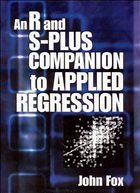Nicht lieferbar

An R and S-Plus Companion to Applied Regression
Versandkostenfrei!
Nicht lieferbar
Main description:`This book fits right into a needed niche: rigorous enough to give full explanation of the power of the S language, yet accessible enough to assign to social science graduate students without fear of intimidation. It is a tremendous balance of applied statistical firepower and thoughtful explanation. it meets all of the important mechanical needs: each example is given in detail, code and data are freely available, and the nuances of models are given rather than just the bare essentials. It also meets some important theoretical needs: linear models, categorical data analysis, ...
Main description:
`This book fits right into a needed niche: rigorous enough to give full explanation of the power of the S language, yet accessible enough to assign to social science graduate students without fear of intimidation. It is a tremendous balance of applied statistical firepower and thoughtful explanation. it meets all of the important mechanical needs: each example is given in detail, code and data are freely available, and the nuances of models are given rather than just the bare essentials. It also meets some important theoretical needs: linear models, categorical data analysis, an introduction to applying GLMs, a discussion of model diagnostics and useful instructions on writing customized functions' - Jeff Gill, University of Florida, Gainesville
Review quote:
... The text does an outstanding job of providing the necessary mechanics and theory of the S language. I will use this book in every such course that I teach from this point on.. Jeff Gill
... The book provides a valuable supplement to texts on regression analysis and linear models by showing readers how to put into practice the strategies and techniques involved in modern statistical methodology. It explains clearly the use of a very sophisticated and powerful statistical software system. And, while the examples and objectives are focused closely on regression and related techniques, the discussion successfully conveys general advice and principles for statistical computing with the S system.. William Jacoby
Table of contents:
Preface
1. Introducing R and S-PLUS
S Basics
An Extended Illustration
S Functions for Basic Statistics
2. Reading and Manipulating Data
Data Input
Working with Data Frames
Matrices, Arrays, and Lists
Data Attributes, Modes, and Classes
3. Exploring and Transforming Data
Examining Distributions
Examining Relationships
Examining Multivariate Data
Transforming Data
4. Fitting Linear Models
Linear Least-Squares Regression
Dummy-Variable Regression
Analysis of Variance Models
User-Specified Contrasts*
General Linear Hypotheses*
Data and Confidence Ellipses
More on 1m and Model Formulas
5. Fitting Generalized Linear Models
The Structure of GLMs
Models for Categorical Responses
Poisson GLMs for Count Data
Odds and Ends
Fitting GLMs by Iterated Weighted Least-Squares*
6. Diagnosing Problems
Unusual Data
Non-Normal Errors
Non-Constant Error Variance
Nonlinearity
Collinearity and Variable Selection
Diagnostics for Generalized Linear Models
7. Drawing Graphs
A General Approach to S Graphics
Putting it Together
Effect Displays
Graphics Devices
8. Writing Programs
Defining Functions
Working With Matrices*
Program Control: Conditionals, Loops, and Recursion
Apply and its Relatives
Object-Oriented Programming in S*
Writing S Programs
`This book fits right into a needed niche: rigorous enough to give full explanation of the power of the S language, yet accessible enough to assign to social science graduate students without fear of intimidation. It is a tremendous balance of applied statistical firepower and thoughtful explanation. it meets all of the important mechanical needs: each example is given in detail, code and data are freely available, and the nuances of models are given rather than just the bare essentials. It also meets some important theoretical needs: linear models, categorical data analysis, an introduction to applying GLMs, a discussion of model diagnostics and useful instructions on writing customized functions' - Jeff Gill, University of Florida, Gainesville
Review quote:
... The text does an outstanding job of providing the necessary mechanics and theory of the S language. I will use this book in every such course that I teach from this point on.. Jeff Gill
... The book provides a valuable supplement to texts on regression analysis and linear models by showing readers how to put into practice the strategies and techniques involved in modern statistical methodology. It explains clearly the use of a very sophisticated and powerful statistical software system. And, while the examples and objectives are focused closely on regression and related techniques, the discussion successfully conveys general advice and principles for statistical computing with the S system.. William Jacoby
Table of contents:
Preface
1. Introducing R and S-PLUS
S Basics
An Extended Illustration
S Functions for Basic Statistics
2. Reading and Manipulating Data
Data Input
Working with Data Frames
Matrices, Arrays, and Lists
Data Attributes, Modes, and Classes
3. Exploring and Transforming Data
Examining Distributions
Examining Relationships
Examining Multivariate Data
Transforming Data
4. Fitting Linear Models
Linear Least-Squares Regression
Dummy-Variable Regression
Analysis of Variance Models
User-Specified Contrasts*
General Linear Hypotheses*
Data and Confidence Ellipses
More on 1m and Model Formulas
5. Fitting Generalized Linear Models
The Structure of GLMs
Models for Categorical Responses
Poisson GLMs for Count Data
Odds and Ends
Fitting GLMs by Iterated Weighted Least-Squares*
6. Diagnosing Problems
Unusual Data
Non-Normal Errors
Non-Constant Error Variance
Nonlinearity
Collinearity and Variable Selection
Diagnostics for Generalized Linear Models
7. Drawing Graphs
A General Approach to S Graphics
Putting it Together
Effect Displays
Graphics Devices
8. Writing Programs
Defining Functions
Working With Matrices*
Program Control: Conditionals, Loops, and Recursion
Apply and its Relatives
Object-Oriented Programming in S*
Writing S Programs



